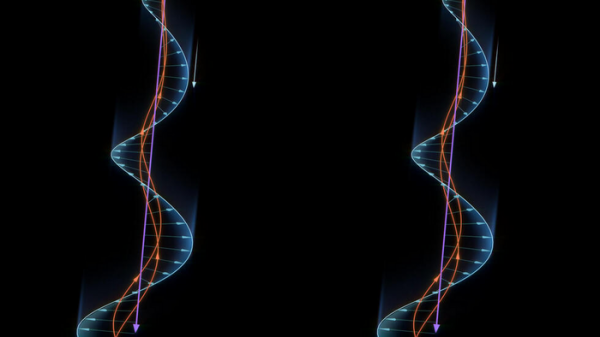For the first time, a group from Nagoya University in Japan detected energy transfer from resonant electrons to whistler-mode waves in space. Their results provide concrete evidence of earlier postulated efficient growth, as anticipated by the wave non-linear growth theory. This should help scientists understand not only space plasma physics but also space weather, which affects satellites.

Whistler-mode wave magnetic field (blue arrows with spiral) propagating along the magnetic field (purple) interacting with electrons (red) passing through it. Image Credit: University of Tokyo
When most people envisage outer space, they envision it as a complete vacuum. This perception is incorrect since the vacuum is filled with charged particles. The density of charged particles in deep space is so low that they seldom collide with each other. Instead of collisions, the motion of charged particles is controlled by forces connected to the electric and magnetic fields that fill space.
Except for relatively close celestial objects like stars, moons, or planets, this lack of collisions persists throughout space. In these instances, the charged particles are no longer going through space, but rather through a medium in which they can collide with other particles.
These charged-particle interactions generate waves everywhere throughout the Earth, including electromagnetic whistler-mode waves, which scatter and propel some of the charged particles. When diffuse auroras develop near the poles of planets, observers are witnessing the outcomes of a wave-electron interaction.
Because electromagnetic fields are so crucial in space weather, researchers should be able to forecast fluctuations in the intensity of very energetic particles by examining these interactions. This could help safeguard astronauts and satellites from the most severe space weather effects.
A team headed by Designated Assistant Professor Naritoshi Kitamura and Professor Yoshizumi Miyoshi of Nagoya University’s Institute for Space and Earth Science (ISEE), along with scientists from the University of Tokyo, Kyoto University, Tohoku University, Osaka University, Japan Aerospace Exploration Agency (JAXA), and several international collaborators, primarily used data collected using low-energy electron spectrometers, known as Fast Plasma Investigation-Dual Electron Spectrometers, on board NASA’s Magnetospheric Multiscale spacecraft.
Researchers looked at interactions between electrons and whistler-mode waves. They were able to directly identify the continuous energy transfer from resonant electrons to whistler-mode waves at the position of the spacecraft in space by employing a way of using a wave particle interaction analyzer. They calculated the wave’s growth rate based on this. The findings were published in the journal Nature Communications.
The most noteworthy discovery was that the observed findings supported the idea that non-linear growth occurred in this interaction.
This is the first time anybody has directly observed the efficient growth of waves in space for the wave-particle interaction between electrons and whistler-mode waves. We expect that the results will contribute to research on various wave-particle interactions and to also improve our understanding of the progress of plasma physics research.
Naritoshi Kitamura, Designated Assistant Professor, Institute for Space and Earth Science, Nagoya University
Naritoshi Kitamura concludes, “As more specific phenomena, the results will contribute to our understanding of the acceleration of electrons to high energies in the radiation belt, which are sometimes called ‘killer electrons’ because they inflict damage on satellites, as well as the loss of high-energy electrons in the atmosphere, which form diffuse auroras.”